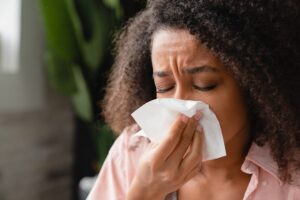 Spring is here, and there are signs of life beginning to bud and bloom. And if you’re one of the millions of people with seasonal allergies, it also means sneezing, congestion, and a bunch of bothersome symptoms.
Spring is here, and there are signs of life beginning to bud and bloom. And if you’re one of the millions of people with seasonal allergies, it also means sneezing, congestion, and a bunch of bothersome symptoms.
Seasonal allergies, also called hay fever or allergic rhinitis, can make you miserable. No one wants to spend their spring indoors for fear of an allergy attack.
Advertisement
There are things you can do to prevent symptoms and breathe easier so you can feel better and still enjoy some of the season. Here are a few strategies that may make your allergies less miserable.
Reduce exposure to allergy triggers
The less exposure, the better, so try…
• Staying indoors on windy days. The best time to go outside is right after a rain, which helps to clear pollen from the air.
• Avoiding tasks like lawn mowing, weed pulling, and other gardening chores that can stir up allergies. Call your kids.
• Remove clothes you’ve worn outside and shower to rinse pollen from your skin and hair.
• Wearing a facemask if you have to do outdoor chores.
• Avoid hanging laundry outside (pollen will stick to your sheets, towels, etc.)
Take extra steps when pollen counts are high
• Check TV, radio, and apps for pollen forecasts and levels to help you prepare your day
• If high pollen is forecasted, start taking allergy medications before symptoms start
• Close windows and doors
• Avoid outdoor activity early in the morning when pollen counts are typically the highest
Keep indoor space clean
Allergens can get inside and make it hard to breathe inside. Although there are no miracle products that can fully eliminate allergens from the air in your home, you can …
• Use air conditioning in your home and car
• If you have forced heating or air conditioning, use high-efficiency filters and follow regular maintenance schedules
• Keep indoor air dry with a dehumidifier
• Use a portable high-efficiency particulate air (HEPA) filter in the bedroom
• Clean floors often with a HEPA filter vacuum
You can prevent and treat symptoms with a variety of medications, ranging from antihistamines to nasal sprays. One natural and effective method to relieve congestion is to rinse the sinuses.
Rinsing the nasal passage with a saline solution is a quick, inexpensive, and effective way to relieve congestion; it directly flushes mucus and allergens from your nose.
You can purchase a ready-made nasal flush or a kit that just needs water. If you use a kit, use bottled water to lower the risk of infection. You can also make your own solution with 1 quart (1 litre) of water, 1.5 teaspoons (7.5 ml) of canning salt, and 1 teaspoon (5 ml) of baking soda. Be sure to rinse after each use with clean water and allow it to dry in the open air.
